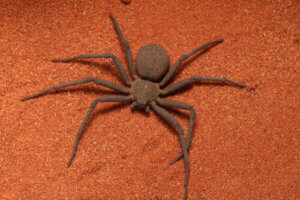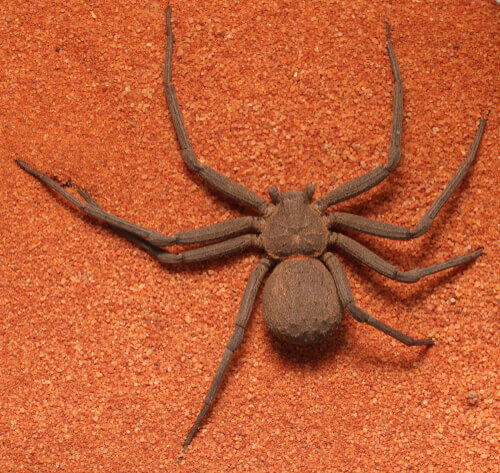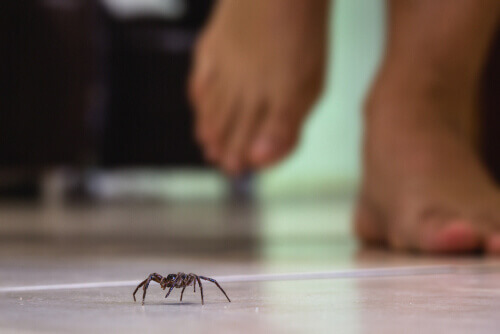The Sicarius Spider and its Lethal Venom

The Sicarius spider belongs to the genus ‘Sicarius’, and people also call it ‘sand spider’, ‘six-eyed spider’, or ‘killer spider’. In fact, its scientific name Sicarius comes from the Latin meaning ‘killer’. These spiders inhabit the African deserts and arid areas of South and Central America.
Currently, 124 species are known to belong to this family and are distributed in two genera: Loxosceles, with 103 species and Sicarius, with 21. All these species are considered of medical importance, as their venom carries an agent that induces skin necrosis. Out of the two genera, the venom of Sicarius spiders is reported as the most toxic.
Important facts about Sicarius spiders
Here are some characteristics that define this interesting invertebrate:
- They’re actually shy in the wild and usually non-aggressive. Spiders of the genus Sicarius don’t produce spider web. They spend their lives burying themselves in the sand or earth, hidden under the stones, or in a burrow. Thus, it’s common for them to have their bodies covered with sand particles.
- Because of their life habits, they’re endemic to desert areas and arid environments.
- As for their size, the genus of Sicarius spiders is the largest: their bodies are around 0.6 inches long and between 2 to 2.3 inches if we add the length of their legs.
- The animal’s outer cuticle is densely covered with small hair-like spines.
- As for the color, they can be yellowish or reddish-brown.
- They have 6 separate small eyes arranged in a U-shaped curved row.
- These spiders live for at least 12 years.

What do these spiders eat?
All Sicarius spiders are carnivorous, although there’s little data on their usual prey. However, there are testimonies that claim that captured species, both in Africa and America, eat cockroaches, ants, crickets, scorpions, and spiders in their natural environment. In addition, there’s no evidence that they hunt or eat any vertebrates.
Do they deserve the reputation of killers?
First of all, it’s appropriate to mention that the severity of this spider’s bite will greatly depend on several factors:
- Whether the poison at the time of inoculation contains its toxic components. People usually don’t know that the poison’s composition will vary. There’s a comparative analysis that suggests that this variation of the venom may correlate with its location, habitat, and hunting strategies.
- Whether the amount of poison injected is sufficient to cause poisoning. The poison’s production is of limited capacity. In the case of Sicarius spiders, a production of between 0.15 to 0.23 milligrams has been reported in optimal “milking” conditions.
- Whether the spider’s jaws are strong enough to penetrate the skin. In this case, this spider’s jaws aren’t particularly robust.
- Last but not least, the possibility of coming into contact with humans. This point is very important, as we can often find in medical literature that species of Sicarius spiders are dispersed outside their endemic area (North America). However, rarely do these authors provide corroborative evidence that this actually happens. Without catching the spider, you can only guess which spider is responsible for the bite.
Is it common for this spider to inhabit the human environment?
We should note, that while researching, we found no reports of captured Sicarius spiders in urban environments. However, in the case of spiders of the genus loxoceles (also from the Sicarius family), there are some reports:
- In 1970, studies mentioned having collected 5,450 Loxoceles laeta from 645 Chilean households. However, there were no reported poisonings from spider bites.
- Similarly, 2,055 Brown recluse spiders were collected in a home in Kansas, USA, in a period of 6 months. Despite the staggering number, no one in the family of four had suffered a noticeable poisoning in six years of living in that household.
Thus, there is evidence that the risk of getting a bite from spiders in this family is small even in places with heavy infestation.

What to expect when a Sicarius spider bites?
It’s important to know that there are several categories of spider bites in this case:
- Not noteworthy: Meaning that it causes very little damage and the wound will eventually self-heal without any major issues.
- Mild reactions: Reddening of the skin and itching. A mild injury but typically gets better by self-healing.
- Dermonecrosis: A necrotic skin lesion that experts consider to be the typical reaction to this bite. Studies of this spider’s venom have identified a component within it that is responsible for this lesion: the sphingomyelins D (SMasas D). These are a range of enzymes that catalyze the hydrolysis, which is a rupture of the cells’ lipid membrane.
- Systemic or viscerocutaneous: This spider bite category affects the vascular system, is very rare and potentially fatal.
In addition to spider venom, experts have also isolated these enzymes from bacteria and fungi.
Dermonecrotic toxins show various pathological activities, including platelet aggregation, hemolysis, increased inflammatory response, nephrotoxicity, edema, neurotoxic and insecticide activities.
What can cause dermonecrosis if you live in a non-endemic area for Sicarius spiders?
There are many diseases that can cause necrotic skin lesions but, unfortunately, they aren’t common knowledge. In fact, expert arachnologists think that skin loxoscelism is more common than it should be.
Some of the reported misdiagnoses include Lyme borreliosis, chemical burn, anthrax, and methodicline-resistant Staphylococcus aureus infection, among others.
Have you ever seen a Sicarius spider in person before? We hope you enjoyed learning about them today.
All cited sources were thoroughly reviewed by our team to ensure their quality, reliability, currency, and validity. The bibliography of this article was considered reliable and of academic or scientific accuracy.
- Zobel-Thropp, P. A., Bodner, M. R., & Binford, G. J. (2010). Comparative analyses of venoms from American and African Sicarius spiders that differ in sphingomyelinase D activity. Toxicon, 55(7), 1274-1282.
- Vetter, R. S. (2008). Spiders of the genus Loxosceles (Araneae, Sicariidae): a review of biological, medical and psychological aspects regarding envenomations. The Journal of Arachnology, 36(1), 150-163.
- Richardson-Boedler, C. (1999). Sicarius (Six-Eyed Crab Spider): A homeopathic treatment for Ebola haemorrhagic fever and disseminated intravascular coagulation? British Homeopathic Journal, 88(01), 24-28.
- Newlands, G., & Atkinson, P. (1988). Review of southern African spiders of medical importance, with notes on the signs and symptoms of envenomation. South African medical journal= Suid-Afrikaanse tydskrif vir geneeskunde, 73(4), 235-239.
- Schenone, H., A. Rojas, H. Reyes, F. Villarroel & G. Suarez. (1970). Prevalence of Loxosceles laeta in houses in central Chile. American Journal of Tropical Medicine and Hygiene 19:564–567.
Vetter, R.S. & D.K. Barger. 2002. An infestation of 2,055 brown recluse spiders (Araneae: Sicariidae) and no envenomations in a Kansas home: implications for bite diagnoses in nonendemic areas. Journal of Medical Entomology 39:948–951.
This text is provided for informational purposes only and does not replace consultation with a professional. If in doubt, consult your specialist.